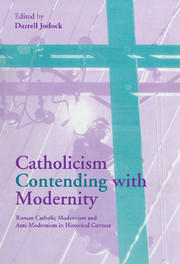 Catholicism Contending with Modernity
Catholicism Contending with Modernity Published online by Cambridge University Press: 30 October 2009
An under-studied dimension of the Modernist crisis is social modernism. During the pontificate of Pius X (1903–1914), the Vatican grew increasingly apprehensive about the way many lay Catholics and clergy were responding to the clamor of the working classes. Approaches to the “social problem” that seemed to undermine the traditional hierarchical and paternalistic structures of authority and social organization were viewed with suspicion. Shortly after the promulgation of the anti-Modernist encyclical Pascendi (1907), the French Catholics of the Semaines sociales were accused of social modernism. This essay will review the Semaine sociale teachings and the accusations of their anti-Modernist critics in order to cast light on the complex conflict of mentalities that divided French Catholics under the Third Republic (1870–1940).
French Catholics were divided over what strategy to adopt to re-Christianize French society. Catholic “restorationists” sought to restore the institutional prerogatives of the Roman Catholic Church, even by way of an alliance with the agnostic, anti-Christian ideologist Charles Maurras and his neo-monarchist political movement of Action française. Catholic “transformationists,” many of whom participated in the Semaines sociales, rejected a top-down, authoritarian imposition of Catholicism in favor of a democratic strategy that viewed the aspirations of the working class for justice as an implicit cry for the kingdom of God.
I will contend, on the one hand, that the dividing line between the social Catholics of the Semaines sociales and their anti-Modernist opponents did not precisely follow the dividing line between doctrinal Modernists and the integralists who were their opponents.
To save this book to your Kindle, first ensure [email protected] is added to your Approved Personal Document E-mail List under your Personal Document Settings on the Manage Your Content and Devices page of your Amazon account. Then enter the ‘name’ part of your Kindle email address below. Find out more about saving to your Kindle.
Note you can select to save to either the @free.kindle.com or @kindle.com variations. ‘@free.kindle.com’ emails are free but can only be saved to your device when it is connected to wi-fi. ‘@kindle.com’ emails can be delivered even when you are not connected to wi-fi, but note that service fees apply.
Find out more about the Kindle Personal Document Service.
To save content items to your account, please confirm that you agree to abide by our usage policies. If this is the first time you use this feature, you will be asked to authorise Cambridge Core to connect with your account. Find out more about saving content to Dropbox.
To save content items to your account, please confirm that you agree to abide by our usage policies. If this is the first time you use this feature, you will be asked to authorise Cambridge Core to connect with your account. Find out more about saving content to Google Drive.